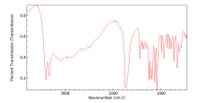
Chemistry
10th Edition
ISBN: 9781305957404
Author: Steven S. Zumdahl, Susan A. Zumdahl, Donald J. DeCoste
Publisher: Cengage Learning
expand_more
expand_more
format_list_bulleted
Question
What is the unknown compound based on the IR Spectrum, explain why or the others are not the compound
![4-Nitro-1,2-benzenedicarboxylic
acid (4-nitrophthalic acid)
2-Methylenebutanedioie acid
(itaconic acid;
methylenesuccinic acid)
5-Bromo-2-hydroxybenzoic acid
(5-bromosalicylic acid)
3,4-Dimethylbenzoic acid
1,2,3-Propanetricarboxylic acid
(tricarballylic acid)
2(+)-Phenylbutanedioic acid
[(±)-phenylsuccinic acid]
165
165
165
166
166
167
2,3-Dihydroxybutanedioic acid
(D- or L-tartaric acid)
169
2-Hydroxy-3-methylbenzoic
acid (3-methylsalicylic acid)
3,5-Dinitro-2-hydroxybenzoic
acid (3,5-dinitrosalicylic acid)
3-Aminobenzoic acid
169
173
174](https://content.bartleby.com/qna-images/question/22b9a576-af91-4102-baf4-cc40d7179ece/6e0a4085-80c7-46cc-9492-2c901660d85f/nnhlv1c_thumbnail.jpeg)
Transcribed Image Text:4-Nitro-1,2-benzenedicarboxylic
acid (4-nitrophthalic acid)
2-Methylenebutanedioie acid
(itaconic acid;
methylenesuccinic acid)
5-Bromo-2-hydroxybenzoic acid
(5-bromosalicylic acid)
3,4-Dimethylbenzoic acid
1,2,3-Propanetricarboxylic acid
(tricarballylic acid)
2(+)-Phenylbutanedioic acid
[(±)-phenylsuccinic acid]
165
165
165
166
166
167
2,3-Dihydroxybutanedioic acid
(D- or L-tartaric acid)
169
2-Hydroxy-3-methylbenzoic
acid (3-methylsalicylic acid)
3,5-Dinitro-2-hydroxybenzoic
acid (3,5-dinitrosalicylic acid)
3-Aminobenzoic acid
169
173
174

Transcribed Image Text:0.8
0.6
0.4-
0.2-
3000
2000
1000
Wavenumber (cm-1)
Percent Transmission (Transmitance)
Expert Solution
This question has been solved!
Explore an expertly crafted, step-by-step solution for a thorough understanding of key concepts.
Step by stepSolved in 2 steps

Knowledge Booster
Learn more about
Need a deep-dive on the concept behind this application? Look no further. Learn more about this topic, chemistry and related others by exploring similar questions and additional content below.Similar questions
- For the structure and 1H NMR spectrum shown below, match the labeled hydrogen atom groups on the molecule (A-F) with the corresponding signals in the spectrum.arrow_forwardCounterfeit drugs are a common problem in developing regions of the world. Oftentimes, counterfeit pills are made with compounds such as lactose. A lab technician has obtained the IR spectrum shown above for a sample reported to be citalopram, an antidepressant drug. Does the IR spectrum belong to citalopram or lactose? Explain your answer by describing what feature of the IR spectrum confirms your choice and describe what feature is missing from the IR spectrum for the other compound. A. citalopram B. lactosearrow_forwardWhat’s the purpose of NMR splitting treearrow_forward
- A.) How many signals does the HNMR of the unknown C6H14O have? B.)Whats the ratio between the number of different hydrogens in the unknown compound C6H14O? C.)Explain splitting patterns of all the signals (in depth if possible the lecture confused me). D.)Explain the chemical shifts of the signals based upon the locations of hydrogens relative to the desheilding groups if any are present in the compound. For A. I think there are 4 signals. For B. I think the ratio is 1:1:3:9 for the hydrogens on the HNMR spectrum. For the last 2 questions (C. and D.) the lecture confused me so an in depth of how you found the answer would be greatly appreciated. Also the unknown for the attached HNMR is C6H14O.arrow_forwardPlease answer the following in photo:arrow_forwardhelparrow_forward
- The question asks how many H signals would we expect to see in the H NMR spectrum. My question is why is the Hydrogen indicated by the arrow any different from the other 2 in circled in red nearby? Does it have to do with it being farthest from the Br?arrow_forwardA total of how many signals are expected in the ¹H spectrum of the given compound? CI оarrow_forwardProvide the structure or SMILES of the compound with molecular formula C8H8O and correlates with the NMR shown in the imagearrow_forward
arrow_back_ios
arrow_forward_ios
Recommended textbooks for you
 ChemistryChemistryISBN:9781305957404Author:Steven S. Zumdahl, Susan A. Zumdahl, Donald J. DeCostePublisher:Cengage Learning
ChemistryChemistryISBN:9781305957404Author:Steven S. Zumdahl, Susan A. Zumdahl, Donald J. DeCostePublisher:Cengage Learning ChemistryChemistryISBN:9781259911156Author:Raymond Chang Dr., Jason Overby ProfessorPublisher:McGraw-Hill Education
ChemistryChemistryISBN:9781259911156Author:Raymond Chang Dr., Jason Overby ProfessorPublisher:McGraw-Hill Education Principles of Instrumental AnalysisChemistryISBN:9781305577213Author:Douglas A. Skoog, F. James Holler, Stanley R. CrouchPublisher:Cengage Learning
Principles of Instrumental AnalysisChemistryISBN:9781305577213Author:Douglas A. Skoog, F. James Holler, Stanley R. CrouchPublisher:Cengage Learning Organic ChemistryChemistryISBN:9780078021558Author:Janice Gorzynski Smith Dr.Publisher:McGraw-Hill Education
Organic ChemistryChemistryISBN:9780078021558Author:Janice Gorzynski Smith Dr.Publisher:McGraw-Hill Education Chemistry: Principles and ReactionsChemistryISBN:9781305079373Author:William L. Masterton, Cecile N. HurleyPublisher:Cengage Learning
Chemistry: Principles and ReactionsChemistryISBN:9781305079373Author:William L. Masterton, Cecile N. HurleyPublisher:Cengage Learning Elementary Principles of Chemical Processes, Bind...ChemistryISBN:9781118431221Author:Richard M. Felder, Ronald W. Rousseau, Lisa G. BullardPublisher:WILEY
Elementary Principles of Chemical Processes, Bind...ChemistryISBN:9781118431221Author:Richard M. Felder, Ronald W. Rousseau, Lisa G. BullardPublisher:WILEY

Chemistry
Chemistry
ISBN:9781305957404
Author:Steven S. Zumdahl, Susan A. Zumdahl, Donald J. DeCoste
Publisher:Cengage Learning

Chemistry
Chemistry
ISBN:9781259911156
Author:Raymond Chang Dr., Jason Overby Professor
Publisher:McGraw-Hill Education

Principles of Instrumental Analysis
Chemistry
ISBN:9781305577213
Author:Douglas A. Skoog, F. James Holler, Stanley R. Crouch
Publisher:Cengage Learning

Organic Chemistry
Chemistry
ISBN:9780078021558
Author:Janice Gorzynski Smith Dr.
Publisher:McGraw-Hill Education

Chemistry: Principles and Reactions
Chemistry
ISBN:9781305079373
Author:William L. Masterton, Cecile N. Hurley
Publisher:Cengage Learning

Elementary Principles of Chemical Processes, Bind...
Chemistry
ISBN:9781118431221
Author:Richard M. Felder, Ronald W. Rousseau, Lisa G. Bullard
Publisher:WILEY